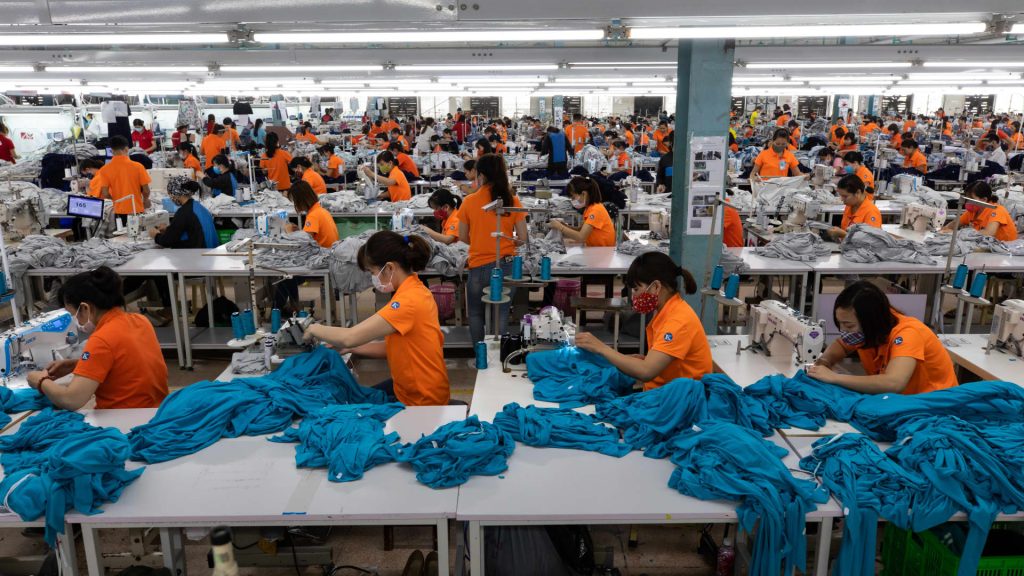Employees at a clothing factory in Vo Cuong, Bac Ninh province, in Vietnam.
SeongJoon Cho/Bloomberg via Getty Images
The Trump administration’s plan to slap steep tariffs on goods from dozens of countries is expected to spike prices for consumers. Some items, like leather goods, will see a bigger jump than others.
The overall impact on households will vary based on their purchasing habits. But most families — especially lower earners — are likely to feel the pain to some degree, economists said.
According to an analysis by the Budget Lab at Yale University, the average household will lose $3,800 of purchasing power per year as a result of all President Donald Trump’s tariff policies — and retaliatory trade actions by other nations — announced as of Wednesday.
That’s a “meaningful amount,” said Ernie Tedeschi, the lab’s director of economics and former chief economist at the White House Council of Economic Advisers during the Biden administration.
The analysis doesn’t include the 34% retaliatory tariff China announced Friday on all U.S. exports, set to take effect April 10. The U.S. exported nearly $144 billion worth of goods to China in 2024, the third-largest market for U.S. goods behind Canada and Mexico, according to the Census Bureau.
Clothing prices poised to spike
The garment industry is among the most susceptible to tariff-related price shocks.
Prices for clothing and shoes, gloves and handbags, and wool and silk products will all increase by between 10% and 20% due to the tariffs Trump has so far imposed, according to the Yale Budget Lab analysis. Tedeschi noted that some of these price increases could take 5 years or more to unfold.
Srdjanpav | E+ | Getty Images
The bulk of apparel and shoes sold in the U.S. is manufactured in China, Vietnam, Sri Lanka and Bangladesh, said Denise Green, an associate professor at Cornell University and director of the Cornell Fashion + Textile Collection.
Under the “reciprocal tariffs” Trump announced Wednesday, Chinese imports will face a 34% duty. Goods from Vietnam, Sri Lanka and Bangladesh face tariffs of 46%, 44% and 37%, respectively.
Taking into account the pre-existing tariffs on China totaling 20%, Beijing now faces an effective tariff rate of at least 54%.
“The tariffs are disastrous for the apparel industry worldwide, but especially for smaller countries with highly specialized garment manufacturing,” Green said.
A lot of clothing production has moved overseas over the last 50 years, Tedeschi said, but it’s “very unlikely” clothing and textile manufacturing will return to the U.S. from Asia in the wake of the new tariffs.
“People will still import clothing to a large extent, and they’ll have to eat the price increase,” he said.
Car prices are another pain point
Various Mercedes-Benz vehicles assembled in the “Factory 56” production hall.
Picture Alliance | Picture Alliance | Getty Images
The duties announced Wednesday are on top of other tariffs Trump has imposed since his second inauguration, including duties on automobiles and car parts; copper, steel and aluminum; and certain imports from Canada and Mexico.
The cost of motor vehicles and car parts could swell by over 8% according to the Yale Budget Lab analysis.
Bank of America estimated that new vehicle prices could increase as much as $10,000 if automakers pass the full impact of tariffs on to consumers.
More from Personal Finance:
Economists say ‘value-added taxes’ aren’t a trade barrier
Tariffs are ‘lose-lose’ for U.S. jobs and industry
Why uncertainty makes the stock market go haywire
“Rising car prices are already a major pain point for the vast majority of Americans who live in an area where they need a car to get to work, school, their kids’ activities, and medical appointments,” said Erin Witte, director of consumer protection for the Consumer Federation of America.
“These tariffs will make it much worse, and will significantly reduce Americans’ choices about what car they want to buy,” she said.
Tariffs on specific commodities like aluminum and steel affect consumers indirectly, since the materials are used to manufacture a swath of consumer goods.
White House spokesman Kush Desai pushed back on analyses that prices will spike because of Trump’s tariff policy.
“Chicken Little ‘expert’ predictions didn’t quite pan out during President Trump’s first term, and they’re not going to pan out during his second term when President Trump again restores American Greatness from Main Street to Wall Street,” Desai said in an e-mailed statement.
Trump’s second-term tariffs are orders of magnitude larger than his first term, however.
The first Trump administration put tariffs on about $380 billion worth of goods in 2018 and 2019, according to the Tax Foundation. The tariffs so far imposed in Trump’s second term affect more than $2.5 trillion of U.S. imports, it said.
There’s also evidence that the first-term tariffs raised prices for some consumers.
Retail prices for the typical washing machine and clothing dryer rose by about 12% each — about $86 and $92 per unit, respectively — due to 2018 tariffs on imports of washing machines, according to a study by economists at the Federal Reserve Board and University of Chicago. The increased cost to consumers totaled $1.5 billion a year, the study found.
Tariffs are expected to raise the U.S. inflation rate
Economists also expect the overall U.S. inflation rate to jump due to tariffs.
American businesses that import goods from abroad will be the ones on the hook for paying the cost of tariffs, and economists anticipate that companies will pass at least some of those costs on to consumers.
The tariffs are disastrous for the apparel industry worldwide, but especially for smaller countries with highly specialized garment manufacturing.
Denise Green
director of the Cornell Fashion + Textile Collection
An environment of rising prices for foreign goods may give U.S. businesses cover to somewhat raise their prices, too.
As a result, the consumer price index could jump to 4.5% later in 2025, Capital Economics estimated Thursday. That’s up from 2.8% in February, and roughly double the Federal Reserve’s long-term inflation target.

